The Use of Sargasso Seaweed as Lignocellulosic Material for Particleboards: Technical Viability and Life Cycle Assessment
Abstract
1. Introduction
2. Materials and Methods
2.1. Chemical and Anatomical Characterization of Particles
2.2. Multilayer Panel Production
2.3. Characterization of the Panels
2.4. Life Cycle Assessment
3. Results
3.1. Chemical and Anatomical Properties of Particles
3.2. Panel Physical and Mechanical Properties
3.3. Particleboard Microstructural Analysis
3.4. Life Cycle Assessment
4. Conclusions
Author Contributions
Funding
Data Availability Statement
Acknowledgments
Conflicts of Interest
References
- Roe, H.S.J.; Freestone, D.; Sapsford, F. The Sargasso Sea High Seas EBSA After Ten Years: Is It Still Relevant and How Has It Helped Conservation Efforts? Front. Mar. Sci. 2022, 9, 821182. [Google Scholar] [CrossRef]
- Martin, L.M.; Taylor, M.; Huston, G.; Goodwin, D.S.; Schell, J.M.; Siuda, A.N.S. Pelagic Sargassum morphotypes support different rafting motile epifauna communities. Mar. Biol. 2021, 168, 115. [Google Scholar] [CrossRef]
- De Széchy MT, M.; Guedes, P.M.; Baeta-Neves, M.H.; Oliveira, E.N. Verification of Sargassum natans (Linnaeus) Gaillon (Heterokontophyta: Phaeophyceae) from the Sargasso Sea off the coast of Brazil, western Atlantic Ocean. Check List. 2012, 8, 638–641. [Google Scholar] [CrossRef]
- Wang, M.; Hu, C.; Barnes, B.B.; Mitchum, G.; Lapointe, B.; Montoya, J.P. The great Atlantic Sargassum belt. Science 2019, 364, 83–87. [Google Scholar] [CrossRef]
- Johns, E.M.; Lumpkin, R.; Putman, N.F.; Smith, R.H.; Muller-Karger, F.E.; Rueda-Roa, D.T.; Hu, C.; Wang, M.; Brooks, M.T.; Gramer, L.J.; et al. The establishment of a pelagic Sargassum population in the tropical Atlantic: Biological consequences of a basin-scale long distance dispersal event. Prog. Oceanogr. 2020, 182, 102269. [Google Scholar] [CrossRef]
- Djakouré, S.; Araujo, M.; Hounsou-Gbo, A.; Noriega, C.; Bourlès, B. On the potential causes of the recent Pelagic Sargassum blooms events in the tropical North Atlantic Ocean. Biogeosciences Discuss. 2017, 1–20. [Google Scholar] [CrossRef]
- Chávez, V.; Uribe-Martínez, A.; Cuevas, E.; Rodríguez-Martínez, R.E.; van Tussenbroek, B.I.; Francisco, V.; Estévez, M.; Celis, L.B.; Monroy-Velázquez, L.V.; Leal-Bautista, R.; et al. Massive Influx of Pelagic Sargassum spp. on the Coasts of the Mexican Caribbean 2014–2020: Challenges and Opportunities. Water 2020, 12, 2908. [Google Scholar] [CrossRef]
- Lapointe, B.E.; Brewton, R.A.; Herren, L.W.; Wang, M.; Hu, C.; McGillicuddy, D.J.; Lindell, S.; Hernandez, F.J.; Morton, P.L. Morton, Nutrient content and stoichiometry of pelagic Sargassum reflects increasing nitrogen availability in the Atlantic Basin. Nat. Commun. 2021, 12, 3060. [Google Scholar] [CrossRef] [PubMed]
- Skliris, N.; Marsh, R.; Addo, K.A.; Oxenford, H. Oxenford, Physical drivers of pelagic sargassum bloom interannual variability in the Central West Atlantic over 2010–2020. Ocean Dyn. 2022, 72, 383–404. [Google Scholar] [CrossRef]
- Magana-Gallegos, E.; Garcia-Sanchez, M.; Graham, C.; Olivos-Ortiz, A.; Siuda, A.N.S.; van Tussenbroek, B.I. Growth rates of pelagic Sargassum species in the Mexican Caribbean. Aquat. Bot. 2023, 185, 103614. [Google Scholar] [CrossRef]
- Sissini, M.N.; de Barros Barreto, M.B.B.; Széchy, M.T.M.; de Lucena, M.B.; Oliveira, M.C.; Gower, J.; Liu, G.; de Oliveira Bastos, E.; Milstein, D.; Gusmão, F.; et al. The floating Sargassum (Phaeophyceae) of the South Atlantic Ocean—Likely scenarios. Phycologia 2017, 56, 321–328. [Google Scholar] [CrossRef]
- Gower, J.; King, S. The distribution of pelagic Sargassum observed with OLCI. Int. J. Remote Sens. 2020, 41, 5669–5679. [Google Scholar] [CrossRef]
- Machado, C.B.; Maddix, G.-M.; Francis, P.; Thomas, S.-L.; Burton, J.-A.; Langer, S.; Larson, T.R.; Marsh, R.; Webber, M.; Tonon, T. Pelagic Sargassum events in Jamaica: Provenance, morphotype abundance, and influence of sample processing on biochemical composition of the biomass. Sci. Total Environ. 2022, 817, 152761. [Google Scholar] [CrossRef]
- Rossignolo, J.A.; Duran, A.J.F.P.; Bueno, C.; Filho, J.E.M.; Junior, H.S.; Tonin, F.G. Algae application in civil construction: A review with focus on the potential uses of the pelagic Sargassum spp. biomass. J. Environ. Manag. 2022, 303, 114258. [Google Scholar] [CrossRef]
- Solarin, B.B.; Bolaji, D.A.; Fakayode, O.S.; Akinnigbagbe, R.O. Impacts of an invasive seaweed Sargassum hystrix var. fluitans (Børgesen 1914) on the fisheries and other economic implications for the Nigerian coastal waters. IOSR J. Agric. Vet. Sci. 2014, 7, 1–6. [Google Scholar]
- van Tussenbroek, B.I.; Arana, H.A.H.; Rodríguez-Martínez, R.E.; Espinoza-Avalos, J.; Canizales-Flores, H.M.; González-Godoy, C.E.; Barba-Santos, M.G.; Vega-Zepeda, A.; Collado-Vides, L. Collado-Vides, Severe impacts of brown tides caused by Sargassum spp. on near-shore Caribbean seagrass communities. Mar. Pollut. Bull. 2017, 122, 272–281. [Google Scholar] [CrossRef]
- Rodríguez-Muñoz, R.; Muñiz-Castillo, A.I.; Euán-Avila, J.I.; Hernández-Núñez, H.; Valdés-Lozano, D.S.; Collí-Dulá, R.C.; Arias-González, J.E. Assessing temporal dynamics on pelagic Sargassum influx and its relationship with water quality parameters in the Mexican Caribbean. Reg. Stud. Mar. Sci. 2021, 48, 102005. [Google Scholar] [CrossRef]
- Maurer, A.S.; Gross, K.; Stapleton, S.P. Beached Sargassum alters sand thermal environments: Implications for incubating sea turtle eggs. J. Exp. Mar. Bio. Ecol. 2022, 546, 151650. [Google Scholar] [CrossRef]
- Resiere, D.; Valentino, R.; Nevière, R.; Banydeen, R.; Gueye, P.; Florentin, J.; Cabié, A.; Lebrun, T.; Mégarbane, B.; Guerrier, G.; et al. Sargassum seaweed on Caribbean islands: An international public health concern. Lancet 2018, 392, 2691. [Google Scholar] [CrossRef] [PubMed]
- Davis, D.; Simister, R.; Campbell, S.; Marston, M.; Bose, S.; McQueen-Mason, S.J.; Gomez, L.D.; Gallimore, W.A.; Tonon, T. Biomass composition of the golden tide pelagic seaweeds Sargassum fluitans and S. natans (morphotypes I and VIII) to inform valorisation pathways. Sci. Total Environ. 2021, 762, 143134. [Google Scholar] [CrossRef]
- Wang, M.; Hu, C. Satellite remote sensing of pelagic Sargassum macroalgae: The power of high resolution and deep learning. Remote Sens. Environ. 2021, 264, 112631. [Google Scholar] [CrossRef]
- Arana, D.A.; Gil Cortés, T.P.; Escalante, V.C.; Rodríguez-Martínez, R.E. Pelagic Sargassum as a Potential Vector for Microplastics into Coastal Ecosystems. Phycology 2024, 4, 139–152. [Google Scholar] [CrossRef]
- Durand, L.; Sundberg, J.; Rodríguez-martínez, R.E. Ocean and Coastal Seaweed Blooms in Paradise: Ecological Reflexivity, Governance and the Sargassum Crisis in the Mexican Caribbean. Ocean Coast. Res. 2024, 72, e24014. [Google Scholar] [CrossRef]
- Liranzo-Gómez, R.E.; Torres-Valle, A.; Jauregui-Haza, U.J. Risk Perception Assessment of Sargassum Blooms in Dominican Republic. Sustainability 2024, 16, 2186. [Google Scholar] [CrossRef]
- Mohan, P.; Strobl, E. Tourism and Marine Crises: The Impact of Sargassum Invasion on Caribbean Small Island Developing Sates. Ocean Coast. Manag. 2024, 251, 107091. [Google Scholar] [CrossRef]
- Amador-Castro, F.; García-Cayuela, T.; Alper, H.S.; Rodriguez-Martinez, V.; Carrillo-Nieves, D. Valorization of pelagic sargassum biomass into sustainable applications: Current trends and challenges. J. Environ. Manag. 2021, 283, 112013. [Google Scholar] [CrossRef] [PubMed]
- Alamsjah, M.A.; Sulmartiwi, L.; Pursetyo, K.T.; Amin, M.N.G.; Wardani, K.A.K.; Arifianto, M.D. Modifying bioproduct technology of Medium Density Fibreboard from the seaweed waste Kappaphycus alvarezii and Gracilaria verrucosa. J. Indian Acad. Wood Sci. 2017, 14, 32–45. [Google Scholar] [CrossRef]
- Garcia-Garcia, D.; Quiles-Carrillo, L.; Montanes, N.; Fombuena, V.; Balart, R. Manufacturing and Characterization of Composite Fibreboards with Posidonia oceanica Wastes with an Environmentally-Friendly Binder from Epoxy Resin. Materials 2017, 11, 35. [Google Scholar] [CrossRef] [PubMed]
- Rammou, E.; Mitani, A.; Ntalos, G.; Koutsianitis, D.; Taghiyari, H.R.; Papadopoulos, A.N. The Potential Use of Seaweed (Posidonia oceanica) as an Alternative Lignocellulosic Raw Material for Wood Composites Manufacture. Coatings 2021, 11, 69. [Google Scholar] [CrossRef]
- Fiorelli, J.; Bueno, S.B.; Cabral, M.R. Assessment of multilayer particleboards produced with green coconut and sugarcane bagasse fibers. Constr. Build. Mater. 2019, 205, 1–9. [Google Scholar] [CrossRef]
- Milagres, E.G.; Barbosa, R.A.G.S.; Caiafa, K.F.; Gomes, G.S.L.; Castro, T.A.C.; Vital, B.R. Properties of particleboard panels made of sugarcane particles with and without heat treatment. Rev. Árvore 2019, 43, e430502. [Google Scholar] [CrossRef]
- Yano, B.B.R.; Silva, S.A.M.; Almeida, D.H.; Aquino, V.B.M.; Christoforo, A.L.; Rodrigues, E.F.C.; Junior, A.N.C.; Silva, A.P.; Lahr, F.A.R. Use of sugarcane bagasse and industrial timber residue in particleboard production. BioResources 2020, 15, 4753–4762. [Google Scholar] [CrossRef]
- Duran, A.J.F.P.; Junior, W.E.L.; Pavesi, M.; Fiorelli, J. Assessment of medium density panels of sugarcane bagasse. Ciência Florest. 2023, 33, e69624. [Google Scholar] [CrossRef]
- Silva, D.A.L.; Lahr, F.A.R.; Garcia, R.P.; Freire, F.M.C.S.; Ometto, A.R. Life cycle assessment of medium density particleboard (MDP) produced in Brazil. Int. J. Life Cycle Assess. 2013, 18, 1404–1411. [Google Scholar] [CrossRef]
- Silva, D.A.L.; Lahr, F.A.R.; Pavan, A.L.R.; Saavedra, Y.M.B.; Mendes, N.C.; Sousa, S.R.; Sanches, R.; Ometto, A.R. Do wood-based panels made with agro-industrial residues provide environmentally benign alternatives? An LCA case study of sugarcane bagasse addition to particle board manufacturing. Int. J. Life Cycle Assess. 2014, 19, 1767–1778. [Google Scholar] [CrossRef]
- Silva, V.U.; Nascimento, M.F.; Oliveira, P.R.; Panzera, T.H.; Rezende, M.O.; Silva, D.A.L.; de Moura Aquino, V.B.; Lahr, F.A.R.; Christoforo, A.L. Circular vs. linear economy of building materials: A case study for particleboards made of recycled wood and biopolymer vs. conventional particleboards. Constr. Build. Mater. 2021, 285, 122906. [Google Scholar] [CrossRef]
- Van Soest, P.J. Nutritional Ecology of the Ruminant, 2nd ed.; Cornell University Press: New York, NY, USA, 1994; Available online: http://www.jstor.org/stable/10.7591/j.ctv5rf668 (accessed on 10 November 2021).
- Fiorelli, J.; Curtolo, D.D.; Barrero, N.G.; Savastano, H.; de Jesus Agnolon Pallone, E.M.; Johnson, R. Particulate composite based on coconut fiber and castor oil polyurethane adhesive: An eco-efficient product. Ind. Crops Prod. 2012, 40, 69–75. [Google Scholar] [CrossRef]
- NBR 14810-2; Medium Density Particleboards: Part 2: Requirements and Test Methods. Associação Brasileira de Normas Técnicas: Rio de Janeiro, Brazil, 2018.
- ISO 16893:2016; Wood-Based Panels—Particleboard. International Organization for Standardization: Geneva, Switzerland, 2016.
- ISO 14040:2006; Environmental Management—Life Cycle Assessment—Principles and Framework. International Organization for Standardization: Geneva, Switzerland, 2006.
- ISO 14044:2016; Environmental Management—Life Cycle Assessment—Requirements and Guidelines. International Organization for Standardization: Geneva, Switzerland, 2006.
- Faria, D.L.; Guimarães, I.L.; Sousa, T.B.; Protásio, T.D.P.; Mendes, L.M.; Junior, J.B.G. Technological properties of medium density particleboard produced with soybean pod husk and Eucalyptus wood. Sci. For. 2020, 48, 126. [Google Scholar] [CrossRef]
- Ribeiro, D.P.; Vilela, A.P.; Silva, D.W.; Napoli, A.; Mendes, R.F. Effect of Heat Treatment on the Properties of Sugarcane Bagasse Medium Density Particleboard (MDP) Panels. Waste Biomass Valorization 2020, 11, 6429–6441. [Google Scholar] [CrossRef]
- Bueno, C.; Rossignolo, J.A.; Gavioli, L.M.; Sposito, C.C.A.; Tonin, F.G.; Veras, M.M.; de Moraes, M.J.B.; Lyra, G.P. Life Cycle Assessment Applied to End-of-Life Scenarios of Sargassum spp. for Application in Civil Construction. Sustainability 2023, 15, 6254. [Google Scholar] [CrossRef]
- Zhang, L.; Hu, Y. Novel lignocellulosic hybrid particleboard composites made from rice straws and coir fibers. Mater. Des. 2014, 55, 19–26. [Google Scholar] [CrossRef]
- Fiorelli, J.; Gomide, C.A.; Lahr, F.A.R.; Nascimento, M.F.D.; de Lucca Sartori, D.; Ballesteros, J.E.M.; Bueno, S.B.; Belini, U.L. Physico-chemical and anatomical characterization of residual lignocellulosic fibers. Cellulose 2014, 21, 3269–3277. [Google Scholar] [CrossRef]
- Borines, M.G.; de Leon, R.L.; Cuello, J.L. Bioethanol production from the macroalgae Sargassum spp. Bioresour. Technol. 2013, 138, 22–29. [Google Scholar] [CrossRef]
- Ali, I.; Bahadar, A. Red Sea seaweed (Sargassum spp.) pyrolysis and its devolatilization kinetics. Algal Res. 2017, 21, 89–97. [Google Scholar] [CrossRef]
- John, R.P.; Anisha, G.S.; Nampoothiri, K.M.; Pandey, A. Micro and macroalgal biomass: A renewable source for bioethanol. Bioresour. Technol. 2011, 102, 186–193. [Google Scholar] [CrossRef]
- Wi, S.G.; Kim, H.J.; Mahadevan, S.A.; Yang, D.-J.; Bae, H.-J. The potential value of the seaweed Ceylon moss (Gelidium amansii) as an alternative bioenergy resource. Bioresour. Technol. 2009, 100, 6658–6660. [Google Scholar] [CrossRef]
- Alzate-Gaviria, L.; Domínguez-Maldonado, J.; Chablé-Villacís, R.; Olguin-Maciel, E.; Leal-Bautista, R.M.; Canché-Escamilla, G.; Caballero-Vázquez, A.; Hernández-Zepeda, C.; Barredo-Pool, F.A.; Tapia-Tussell, R. Presence of Polyphenols Complex Aromatic “Lignin” in Sargassum spp. from Mexican Caribbean. J. Mar. Sci. Eng. 2020, 9, 6. [Google Scholar] [CrossRef]
- Fengel, D.; Wegener, G. Wood Chemistry, Ultrastructure, Reactions; Walterde Gruyter: Berlin, Germany, 1984. [Google Scholar] [CrossRef]
- Nourbakhsh, A.; Baghlani, F.F.; Ashori, A. Nano-SiO2 filled rice husk/polypropylene composites: Physico-mechanical properties. Ind. Crops Prod. 2011, 33, 183–187. [Google Scholar] [CrossRef]
- Ahmed, H.B.; Helal, M.H.; Abdo, M.H.; Fekry, M.M.; Abdelhamid, A.E. Disarmament of micropollutants from wastewater using nylon waste/chitosan blended with algal biomass as recoverable membrane. Polym. Test. 2021, 104, 107381. [Google Scholar] [CrossRef]
- Harris, N.; Gibbs, D. Forests Absorb Twice as Much Carbon as They Emit Each Year. World Resour. Inst. 2021, 21. Available online: https://www.wri.org/insights/forests-absorb-twice-much-carbon-they-emit-each-year (accessed on 6 February 2024).
- Empresa de Pesquisa Energética. National Energy Balance—BEN 2022, Empresa de Pesquisa Energética. 2023. Available online: https://www.epe.gov.br/pt/publicacoes-dados-abertos/publicacoes/balanco-energetico-nacional-2022 (accessed on 20 January 2023).
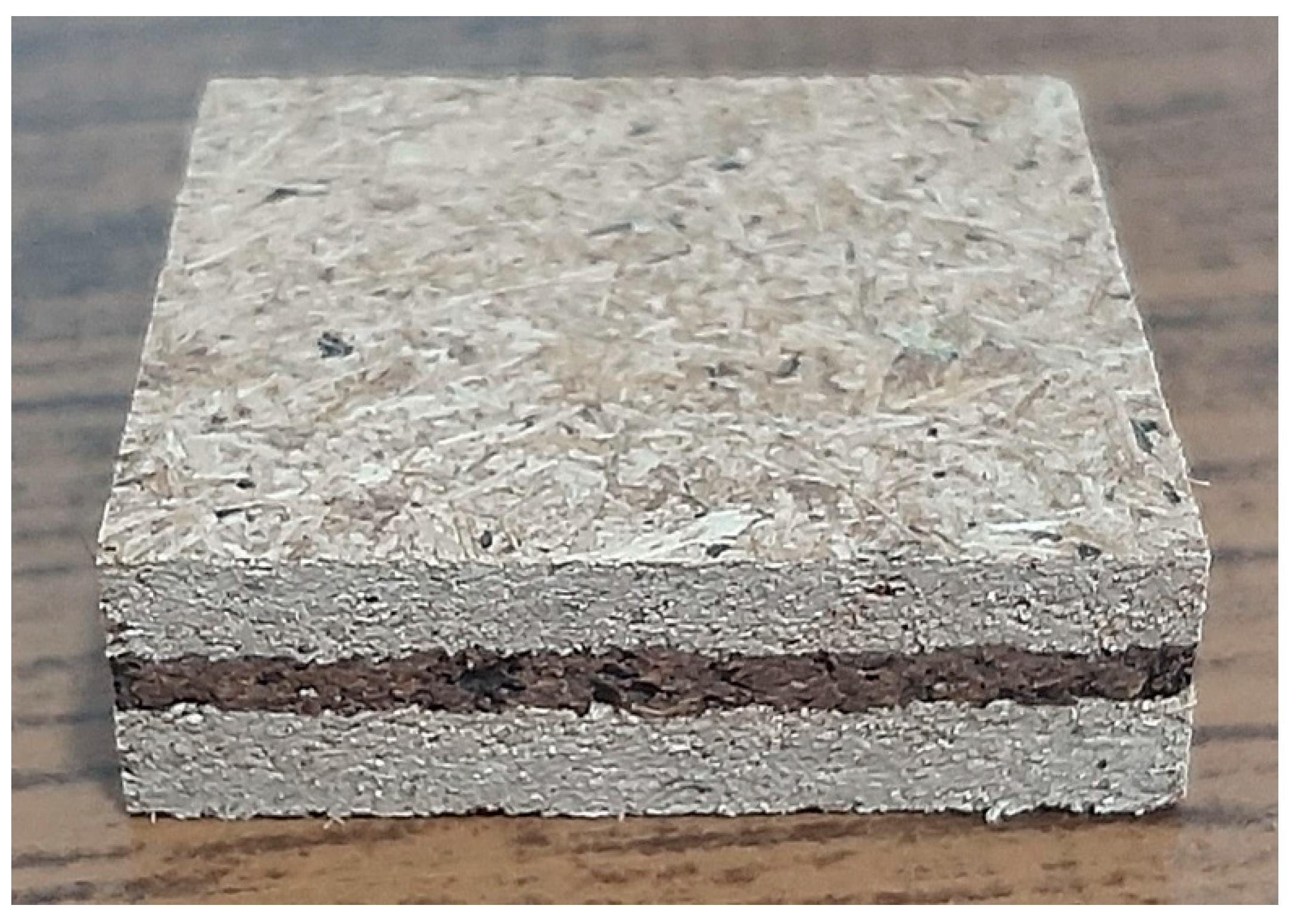
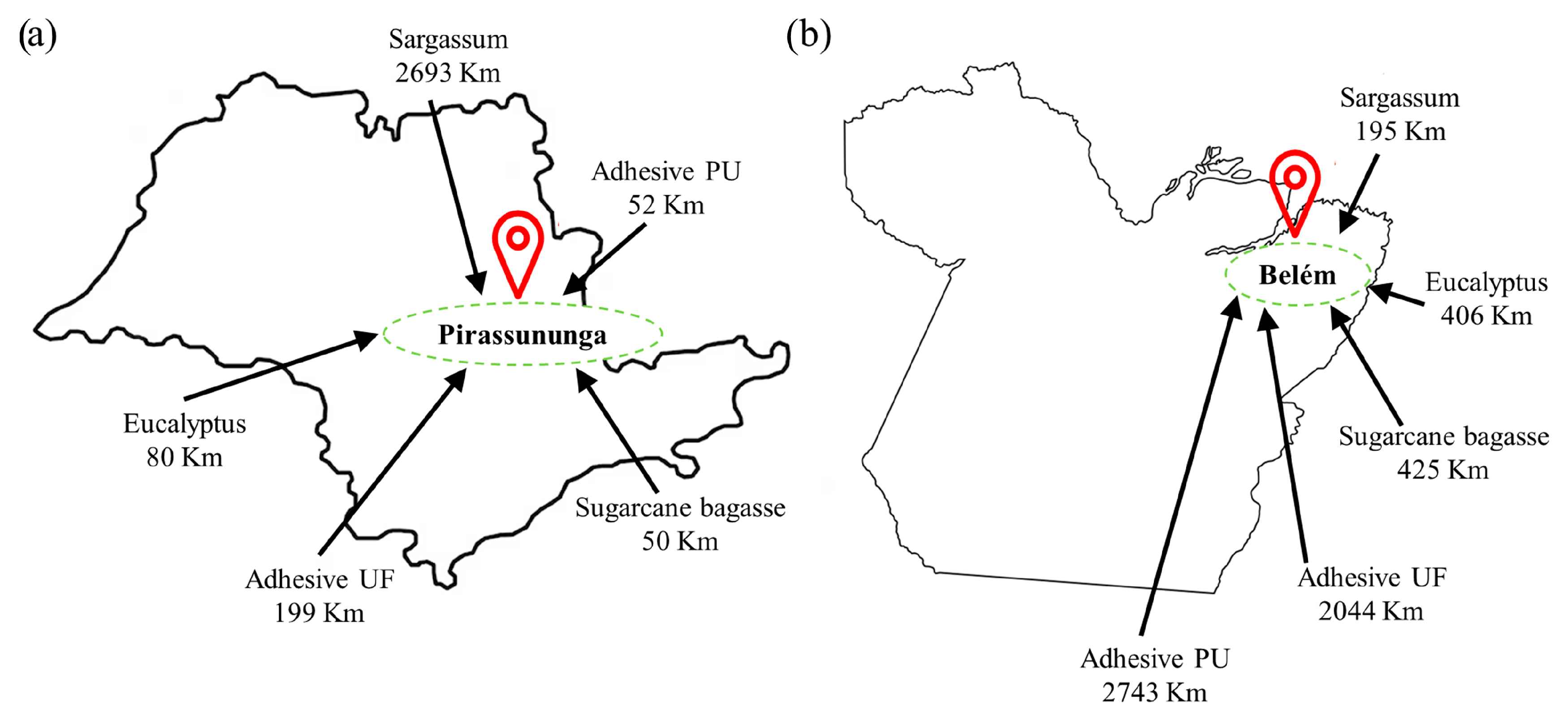

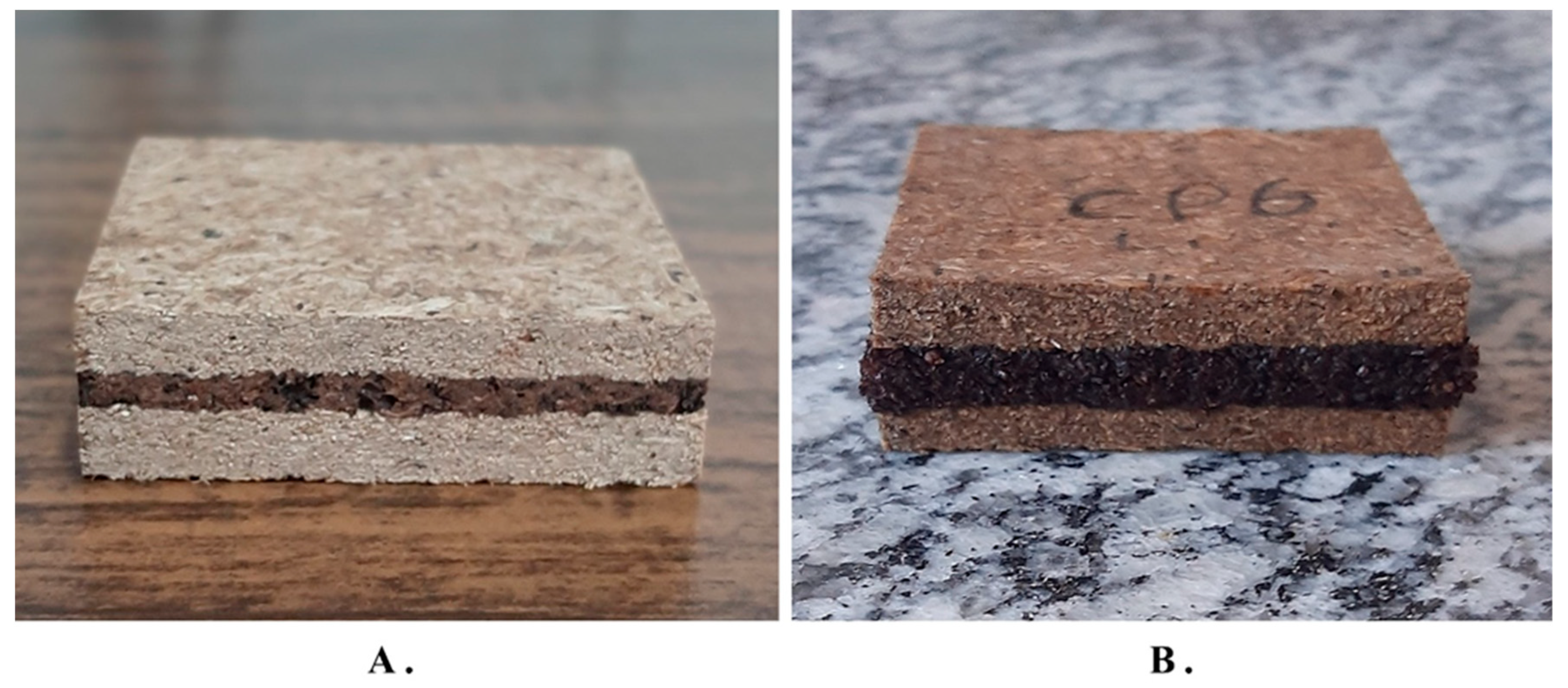

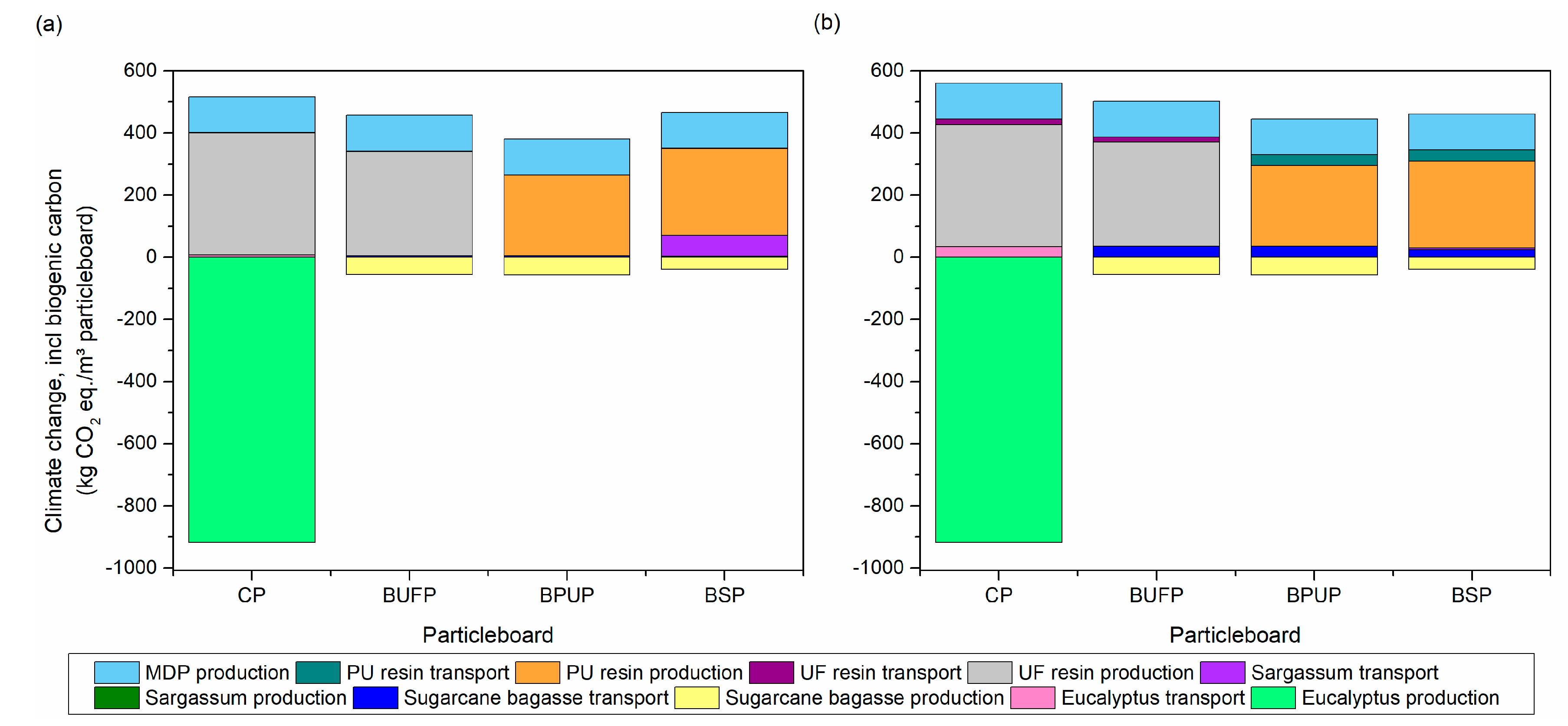

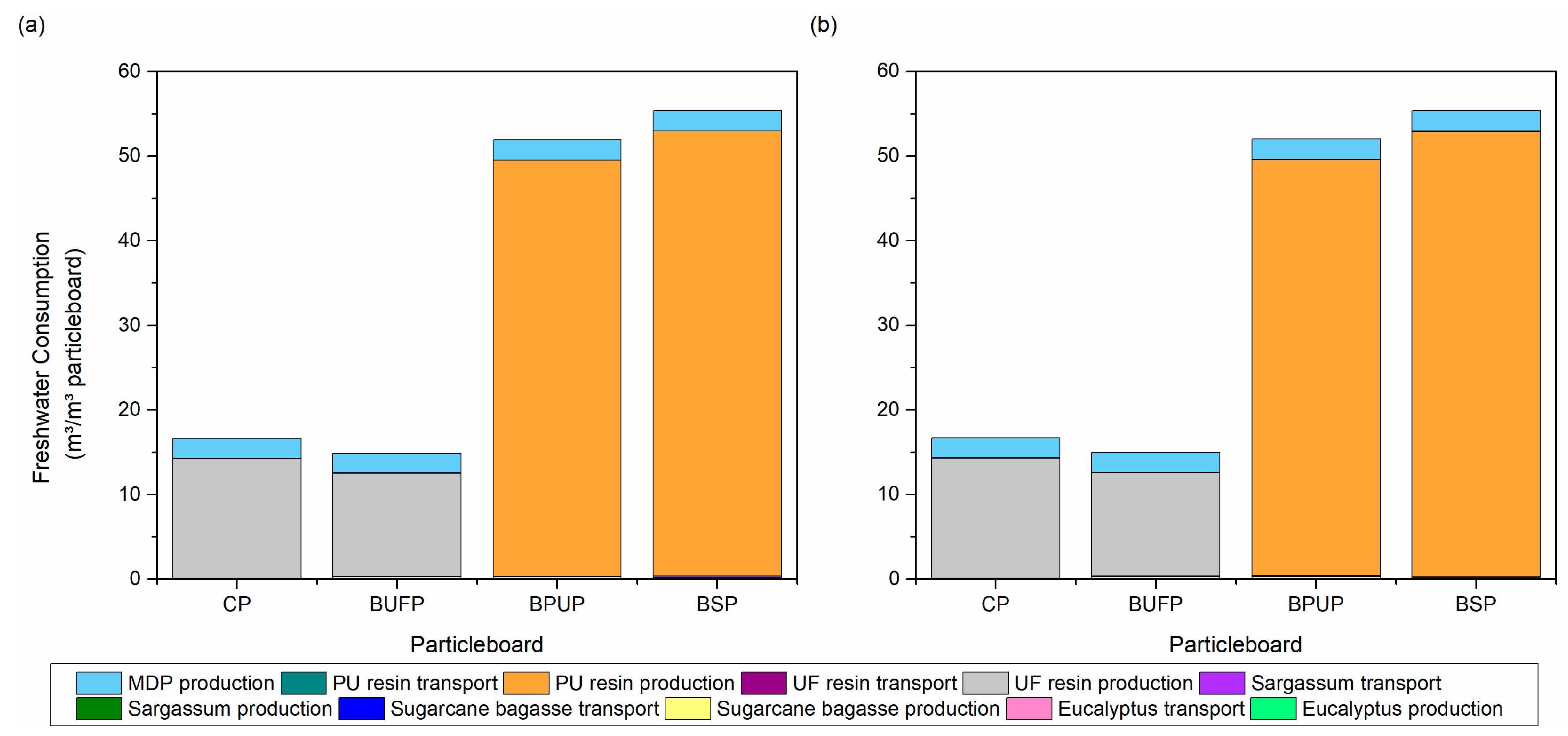
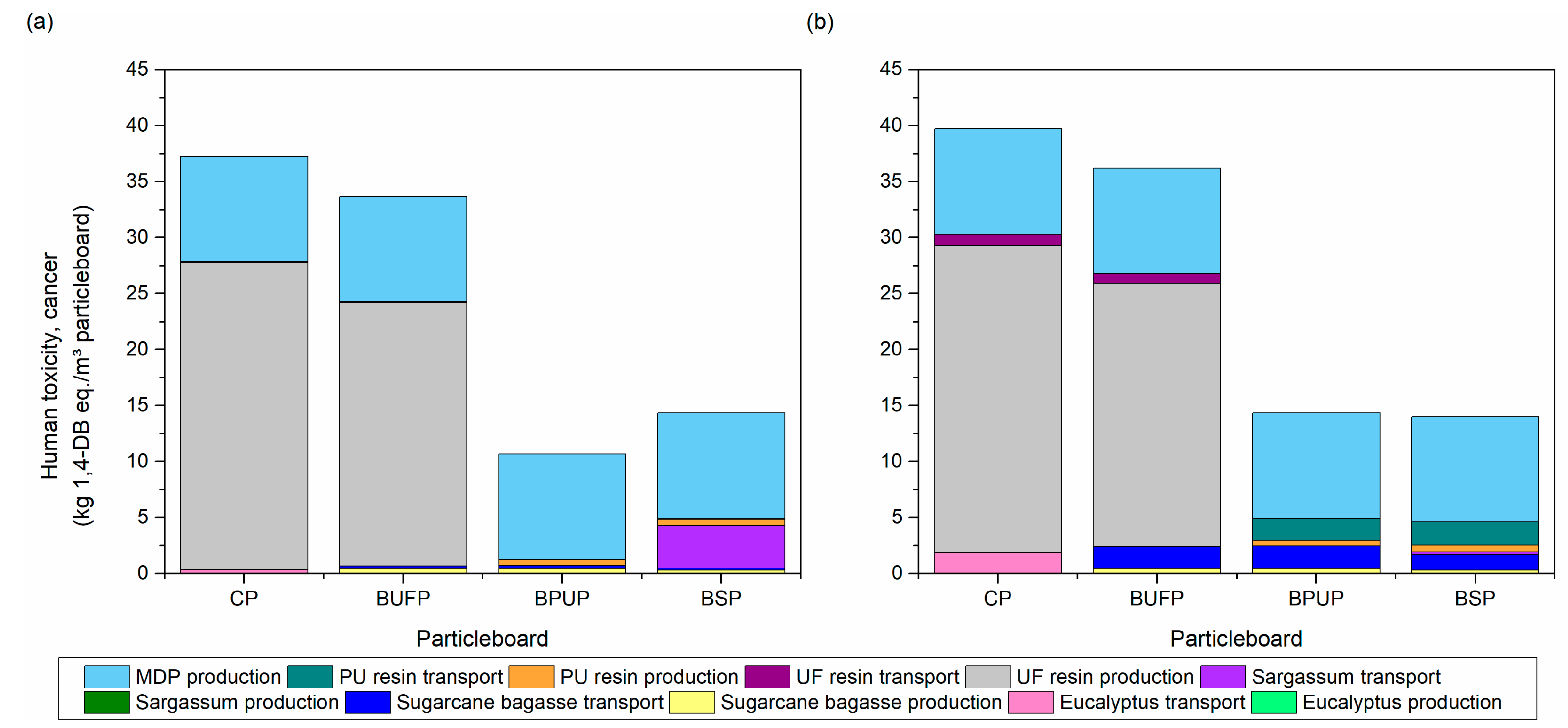

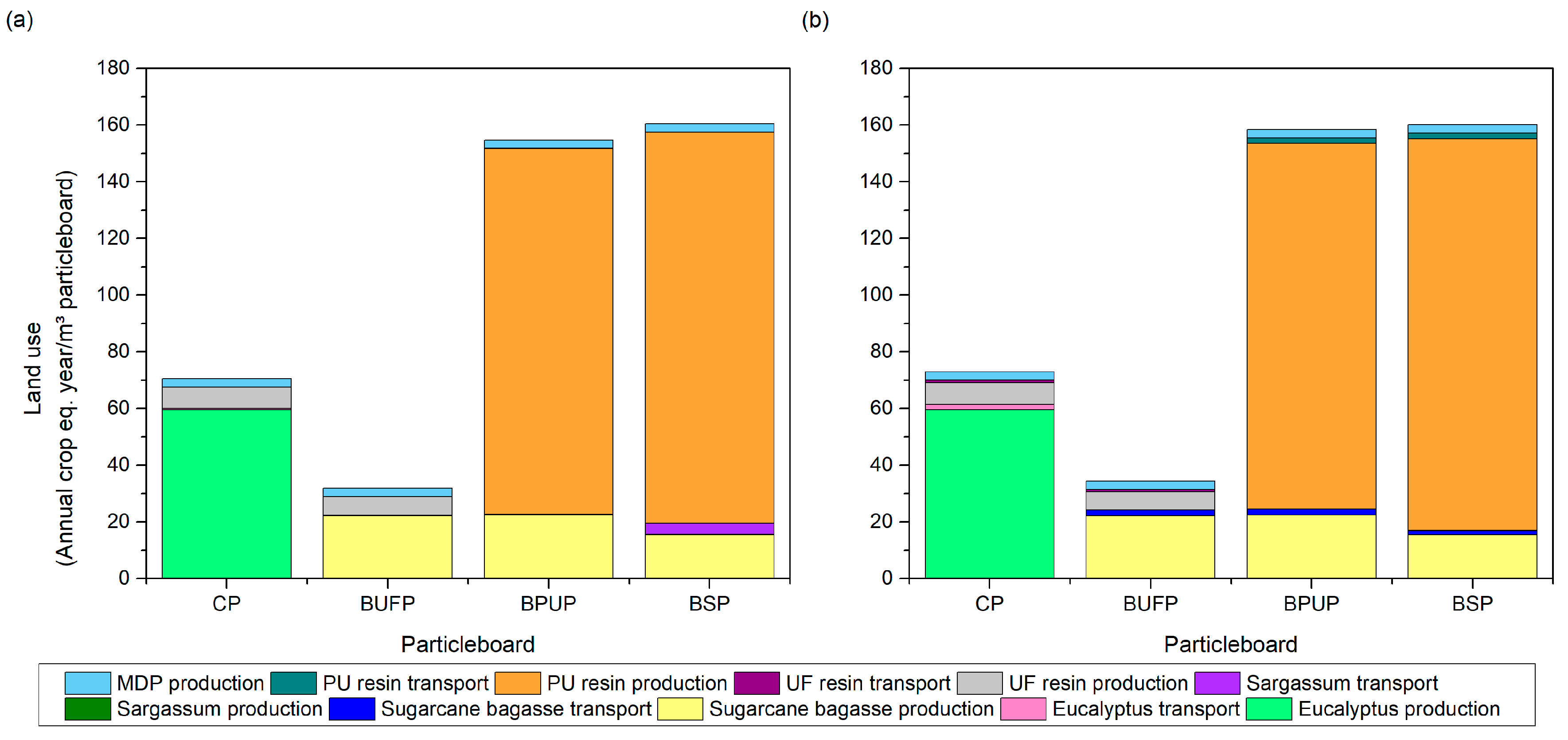

| Panels | Panel Composition | |||||
|---|---|---|---|---|---|---|
| Eucalyptus (kg) | Sugarcane Bagasse (kg) | Sargassum (kg) | Urea-Formaldehyde Resin (UF) (kg) | Castor Bean Polyurethane Resin (PU) (kg) | Reference | |
| CP | 630 | - | - | 70 | - | Faria et al. [43] |
| BUFP | - | 640 | - | 60 | - | Ribeiro et al. [44] |
| BPUP | - | 651 | - | - | 99 | Duran et al. [33] |
| BSP | - | 447 | 198 | - | 106 | This study |
| Processes’ Inputs and Outputs | Data Source |
|---|---|
| Inputs | |
| Materials | |
| Sargassum particle | Bueno et al. [45] |
| Eucalyptus | SICV Brazil |
| Sugarcane bagasse; BR: market for bagasse, from sugarcane | Ecoinvent 3.7.1 |
| Castor-oil-based polyurethane resin; EU-28: 2-component PUR adhesive based on polyether and castor oil (modified energy consumption based on a Brazilian industry) | |
| Urea-formaldehyde resin; RER: melamine formaldehyde resin production | |
| Lubricating oil; RER: lubricating oil production | |
| Diesel; BR: diesel, import from Row | |
| Heavy fuel oil; BR: heavy fuel oil, import from Row | |
| Transport | |
| Transport; RoW: transport, freight, lorry, all sizes; EURO3 to generic market for transport, freight, lorry, and unspecified. | Ecoinvent 3.7.1 |
| Electricity consumption | |
| Electricity; BR: electricity, high voltage, production mix | Ecoinvent 3.7.1 |
| Outputs | |
| Medium-density multilayer panels | - |
| Waste | Cellulose (% *) | Hemicellulose (% *) | Lignin (% *) | Source |
|---|---|---|---|---|
| Pelagic Sargassum | 41.48 | 3.21 | 16.94 | This study |
| Sugarcane bagasse | 50.47 | 30.56 | 10.74 | Fiorelli et al. [47] |
| Pinus spp. | 51.13 | 15.10 | 27.29 | Fiorelli et al. [47] |
| Medium-Density Panels | ρ | Adhesive | TS | MOR | MOE | IB | Source |
|---|---|---|---|---|---|---|---|
| (kg/m3) | (%) | (MPa) | (MPa) | (MPa) | |||
| 24 h | |||||||
| Sugarcane bagasse and Sargassum | 750 | PU | 19.81 | 16.31 | 2162 | 0.49 | This study |
| (sd) | 0.84 | 1.30 | 273.25 | 0.15 | |||
| Sugarcane bagasse | 700 | UF | 9.9 | 15.6 | 2021 | 0.48 | Ribeiro et al. [44] |
| Sugarcane bagasse | 750 | PU | 14.99 | 15.48 | 1885 | 1.02 | Duran et al. [33] |
| Eucalyptus | 700 | UF | 11.50 | 18.71 | 1841 | 0.65 | Faria et al. [43] |
| NBR 14810-2:2018—Non-structural use in dry conditions (P2) | 551–750 | 22 | 11 | 1600 | 0.35 | ||
| ISO 16893-2016—General purpose for use in dry conditions | - | - | 10 | - | 0.24 | ||
| ISO 16893-2016—Furniture grade for use in dry conditions | - | - | 11 | 1600 | 0.35 | ||
Disclaimer/Publisher’s Note: The statements, opinions and data contained in all publications are solely those of the individual author(s) and contributor(s) and not of MDPI and/or the editor(s). MDPI and/or the editor(s) disclaim responsibility for any injury to people or property resulting from any ideas, methods, instructions or products referred to in the content. |
© 2024 by the authors. Licensee MDPI, Basel, Switzerland. This article is an open access article distributed under the terms and conditions of the Creative Commons Attribution (CC BY) license (https://creativecommons.org/licenses/by/4.0/).
Share and Cite
Duran, A.J.F.P.; Lyra, G.P.; Campos Filho, L.E.; Bueno, C.; Rossignolo, J.A.; Alves-Lima, C.; Fiorelli, J. The Use of Sargasso Seaweed as Lignocellulosic Material for Particleboards: Technical Viability and Life Cycle Assessment. Buildings 2024, 14, 1403. https://doi.org/10.3390/buildings14051403
Duran AJFP, Lyra GP, Campos Filho LE, Bueno C, Rossignolo JA, Alves-Lima C, Fiorelli J. The Use of Sargasso Seaweed as Lignocellulosic Material for Particleboards: Technical Viability and Life Cycle Assessment. Buildings. 2024; 14(5):1403. https://doi.org/10.3390/buildings14051403
Chicago/Turabian StyleDuran, Afonso José Felício Peres, Gabriela Pitolli Lyra, Luiz Eduardo Campos Filho, Cristiane Bueno, João Adriano Rossignolo, Cicero Alves-Lima, and Juliano Fiorelli. 2024. "The Use of Sargasso Seaweed as Lignocellulosic Material for Particleboards: Technical Viability and Life Cycle Assessment" Buildings 14, no. 5: 1403. https://doi.org/10.3390/buildings14051403
APA StyleDuran, A. J. F. P., Lyra, G. P., Campos Filho, L. E., Bueno, C., Rossignolo, J. A., Alves-Lima, C., & Fiorelli, J. (2024). The Use of Sargasso Seaweed as Lignocellulosic Material for Particleboards: Technical Viability and Life Cycle Assessment. Buildings, 14(5), 1403. https://doi.org/10.3390/buildings14051403











